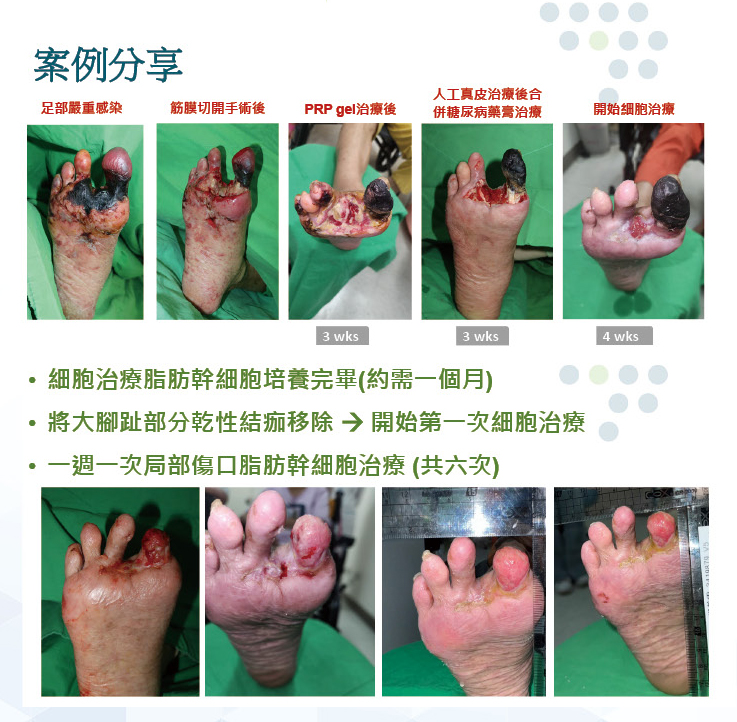New Solutions for Chronic Wounds: Overcoming Challenges with Innovative Approaches! Dr. Chiao Hao-Yu, Physician at the Department of Orthopedic Surgery, Cell Therapy Center.
Update Date:2024/12/04,
Views:248
On November 20, 2024, our hospital held a press conference titled "New Solutions for Difficult Wounds: New Approaches to Overcoming Wound Challenges." During the event, Dr. Chiao Hao-Yu from the Department of Orthopedic Surgery and the Cell Therapy Center shared successful outcomes from using "cell therapy" to provide individualized treatments for patients with difficult-to-heal wounds, showing significant recovery results.
With the rapid advancement of medical technology, many previously challenging-to-treat diseases have found better treatment options, leading to improved outcomes. For example, cardiovascular diseases and diabetes now benefit from more effective medications, including the use of targeted cancer therapies and immune checkpoint inhibitors. These breakthroughs have revolutionized the way we manage and treat chronic conditions, enhancing patients' quality of life and survival rates. As we continue to develop new therapies, the potential for even more innovations in medical care remains promising.
In 2018, the Ministry of Health and Welfare (衛福部) in Taiwan enacted the "Special Management Regulations" (特管法), officially opening the door for six major types of cell therapy. Under strict regulatory control, these therapies are now applicable in fields such as cancer treatment and regenerative medicine. In 2023, the Tri-Service General Hospital (三軍總醫院) officially established its Cell Therapy and Regenerative Medicine Center. This facility offers cross-disciplinary medical services, providing personalized treatment plans that allow patients to receive comprehensive, one-stop care for their medical needs.
These advancements reflect Taiwan's growing commitment to cutting-edge medical treatments, particularly in the area of cell therapy, which has great potential in both oncology and regenerative medicine.
Cell therapy can be broadly classified into two categories based on its purpose:
1. Cancer Treatment: This approach involves expanding the patient's immune cells, such as Cultured Induced Killer (CIK) cells, which are grown and amplified in the lab. These cells are then reintroduced into the patient's body to target and destroy cancer cells.
2. Regenerative Medicine: This involves utilizing the differentiation and proliferative capabilities of stem cells to repair tissue damage. Regenerative therapies can use autologous cells (the patient's own cells), and in the future, allogeneic cells (from a donor) may also be used.
These therapies represent significant advancements in both oncology and regenerative medicine, offering hope for better treatment outcomes in both fields.
Dr. Chiao Hao-Yu, from the Cell Therapy Center, emphasizes that cell therapy is a powerful tool for treating difficult-to-heal wounds. These include wounds that don't improve after four weeks, such as infectious wounds, burns, autoimmune wounds, pressure ulcers, diabetic ulcers, and radiation ulcers.
In the case of diabetic patients, delayed wound healing is often due to an imbalance of macrophages. Traditional treatments might not be sufficient, and repeated doctor visits can lead to further deterioration of the wound, sometimes resulting in amputations. However, with cell therapy, stem cells are placed on the surface of chronic, non-healing wounds, paired with advanced wound dressings, to significantly improve healing. This personalized approach offers a notable advantage over traditional methods in promoting wound recovery.
Cell therapy's potential to heal wounds more effectively marks a significant breakthrough in regenerative medicine.
Dr. Chiao Hao-Yu recently treated a 75-year-old female diabetic patient who had advanced kidney disease and was on dialysis. She developed acute right lower limb vascular occlusion, which necessitated a second-toe amputation. After the wound infection stabilized, PRP (platelet-rich plasma) therapy was used to stimulate tissue activation. Additionally, fat-derived stem cell therapy was applied, using cells taken from her abdomen to reconstruct parts of the necrotic big toe and surrounding foot wounds, significantly minimizing damage and promoting healing. The patient completed her final session of cell therapy last week, coinciding with her birthday, and the medical team celebrated by presenting her with a birthday card. This example showcases the potential of stem cell therapy in healing difficult wounds, offering promising outcomes in patients with complex health issues.
Although cell therapy still faces challenges, such as the time required for obtaining and purifying cell sources, high treatment costs, and the need for long-term evaluations of effectiveness and safety, it holds great promise for the future. As technology and research continue to advance, cell therapy is expected to become a crucial method for treating a wide range of difficult-to-heal diseases. Despite current obstacles, its potential in areas like tissue regeneration and chronic wound healing suggests it will play an increasingly important role in modern medicine.



Dr. Qiao Hao-Yu is an attending physician in the Department of Plastic Surgery at the Tri-Service General Hospital. He specializes in the treatment of large-area burns and the management of difficult wounds. Dr. Qiao is also the director of the Plastic Surgery Ward and holds a position as a board member of the Taiwan Burn and Wound Care Society. He completed his medical studies at the National Defense Medical Center, where he earned his medical degree. He is dedicated to advancing burn care and complex wound management through innovative treatments like cell therapy.